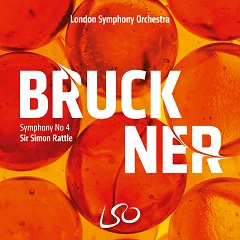Simon Rattle dirigiert auf diesem Album nicht nur die Vierte Symphonie von Anton Brückner in der Fassung von 1878-81, sondern auch die vom Komponisten verworfenen Sätze Scherzo and Finale in der von Benjamin-Gunnar Cohrs erst 2021 veröffentlichten Aufführungsversion sowie die Alternativversionen des Andante quasi Allegretto (in der langen Fassung von 1878) und des Finalsatzes in der ungekürzten Fassung von 1881.
Ein ganz allgemeiner Eindruck ist der, dass Rattle das London Symphony zu einem sehr schlanken und klaren Klang anhält. Der erste Satz erklingt sehr vital und flüssig, das Andante fein differenziert mit wunderbaren Nuancen und sehr gefühlvoll, lieblich aber nicht ohne prononciert dunkle Gedanken. Das ergibt eine sehr narrative musikalische Story mit großer Aussagekraft.
Auch das rhythmisch sehr feine und leicht musizierte Scherzo zeigt, mit welcher Sorgfalt und Liebe Rattle diese Interpretation vorbereitet hat. Auch für das ländliche Trio zeigt er ein gutes Gespür. Die Musik wird nicht rustikal, sondern hat eine delikat-elegante Form.
Das Finale schließlich wird ungewöhnlich stark kontrastiert, manchmal scheint die Musik direkt zu verstummen, um dann wieder beschwingt oder dezidiert aufzurauschen. So kontrastreich, so abwechselnd in den Stimmungen hat man diesen Satz nicht oft gehört. Die Musik wird dadurch auch ungeheuer spannungsvoll und insbesondere auch modern.
Dieselbe Sorgfalt und interpretatorische Intelligenz lässt Rattle auch den Alternativsätzen angedeihen, so dass er sich mit dieser Aufnahme als ein überragender Bruckner-Interpret präsentiert, eine Qualität, die man bei ihm nicht immer so ausgeprägt feststellen konnte.
Simon Rattle conducts on this album not only Anton Brückner’s Fourth Symphony in the 1878-81 version, but also the Scherzo and Finale movements discarded by the composer in the performance version published by Benjamin-Gunnar Cohrs only in 2021, as well as the alternative versions of the Andante quasi Allegretto (in the long 1878 version) and the final movement in the unabridged 1881 version.
A very general impression is that Rattle encourages the London Symphony to sound very lean and clear. The first movement sounds very vital and fluid, the Andante finely differentiated with wonderful nuances and very soulful, lovely but not without pronounced dark thoughts. This results in a very narrative musical story with great expressiveness.
Also the rhythmically very fine and lightly played Scherzo shows with what care and love Rattle has prepared this interpretation. He also shows a good sense for the rural trio. The music does not become rustic, but has a delicately elegant form.
Finally, the finale is unusually sharply contrasted; sometimes the music seems to fall straight into silence, only to roar back upbeat or decidedly so. One has not often heard this movement so rich in contrast, so alternating in moods. This also makes the music tremendously exciting and especially modern.
Rattle gives the same care and interpretive intelligence to the alternative movements, so that he presents himself with this recording as an outstanding Bruckner interpreter, a quality that one could not always find so pronounced with him.


















